News, views and insights on maintaining a healthy edge.
 Good News for Popeye
Good News for Popeye
In the world of healthy eating, spinach and other salad greens are the heroes. In the world of food poisoning, they have often played the role of villains. Over the last decade, no fewer than 18 nationwide food-poisoning outbreaks have been traced back to leafy greens. In 99% of the cases, the problem originates in the way they were washed, which sometimes fails to eliminate bacteria such as E. coli.

William Farrer, MD
Chief of Infectious Diseases Trinitas Regional Medical Center 908.994.5455
Dr. William Farrer, Chief of Infectious Diseases at Trinitas, points out that an outbreak in Europe in 2011 with a toxin-producing E. coli strain linked to sprouts sickened 852 people and killed 32. In the US, the Centers for Disease Control and Prevention estimates that 48 million Americans fall ill to food-related illnesses each year and about 3,000 people die each year from food poisoning. “Our modern food distribution system means that outbreaks linked to leafy vegetables can involve people in multiple states,” observes Dr. Farrer. The good news is that, at the last meeting of the American Chemical Society in Boston, a group of scientists presented a new, simple-to-implement parallel-plate flow chamber system that keeps bacteria from attaching to the outer layer of leaves. This method helps disinfecting rinses get to all parts of leaf surfaces equally; only 85% percent of surfaces on average get properly cleaned now. The USDA has already started funding the project. Dr. Farrer is encouraged by the government response: “Any process that can improve the washing of vegetables can potentially decrease the likelihood of these infections and make our food supply safer.”
 I Can’t Believe It’s Not Healthy
I Can’t Believe It’s Not Healthy
Distressing news for all of us raised on the eat-margarine-not-butter ethos: That thinking may be dead wrong. A survey of 1 million people in 50 recent studies by McMaster University in Canada has concluded that saturated fats from animal products do not appear to increase the risk of death from heart disease, diabetes or stroke.

Michelle Ali, RD
Director, Food and Nutrition, Trinitas Regional Medical Center 908.994.5396
Michelle Ali, Director of Food and Nutrition at Trinitas, explains that “the carbon chain of saturated fats consists of fatty acid ‘saturated’ with hydrogen. Trans fats are created by an industrial process that adds hydrogen to liquid vegetable oils. This addition of hydrogen makes these fats more solid at room temperature and gives them qualities that are similar to shortening or lard. Given that change in consistency, we’ve known for some time that trans fat has been linked to heart disease.” The Canadian researchers concluded that commercially produced trans fats found in snack foods, packaged baked goods and, yes, margarine, raised the risk of premature death by more than 30 percent. The research team was quick to add that this does not mean people should increase their intake of animal fats, which can lead to unhealthy weight gain. We should focus more on eating healthy including more whole grains, fruits, vegetables and lean meats, Ali suggests. “In general, we should reduce our intake of saturated fat and, of course, avoid foods that are known to contain trans fat.”
 Nickel for Your Thoughts
Nickel for Your Thoughts
If you had a nickel for every time you developed a weird skin rash…Well, in some instances, dietary nickel could actually be the culprit. Perhaps counter-intuitively, it’s a common cause of contact dermatitis. If a rash develops on your hands or elbows—or elsewhere after coming into contact with a zipper, belt buckle or other nickel-containing object—you may be mildly allergic to nickel. And the origin of that allergy could be foods such as wheat, rye, nuts, seeds and even chocolate, which are high in nickel. Other causes of nickel allergies can include medical devices containing the metal, including dental and orthopedic implants.
 Mouth to Mouth
Mouth to Mouth
Anthropologists don’t often make their way into the pages of What’s Up, Doc?, but a study by a joint team from Indiana University and the University of Nevada caught our attention. The anthropologists looked at attitudes toward kissing around the world. Although affectionate pecks on the cheek are common across most cultures, especially for babies and children, in most parts of the world romantic kissing kind of creeps people out. Indeed, in the 168 societies studied, only 46 percent see erotic value in the locking of lips. In fact, among cultures in the Amazon, New Guinea and sub-Saharan Africa, romantic kissing is practically unknown. According to

Rodger Goddard, PhD
Chief Psychologist, Trinitas Regional Medical Center Director of Wellness Management Services 908.994.7334
Dr. Rodger Goddard, Chief Psychologist at Trinitas and Director of Wellness Management Services, kissing spans the spectrum from a dangerous, unhygienic transmission of disease to the most intimate and caring exchange of love. And there are health benefits to kissing, too. Dr. Goddard notes that intimacy and positive relationships—whether sealed by a kiss or an old-fashioned hug—have been shown to improve one’s health and longevity. “Theories about the origins and reasons for kissing are varied, including evaluation of another’s most intimate biological, hormonal information to a reinforcement of trust, intimacy, closeness and sexual attraction to another,” he says, adding that, in a recent article by Dr. Noam Shpancer, men and women were found to differ on their views of kissing. “Half of men say they would have sex with a partner without the need for kissing, while only 14% of women would. Women were found to heavily weigh the overall quality of a kiss in their decision for commitment to someone.” Some Pacific island cultures practice a “kiss” where a couple’s lips pass a couple of centimeters apart without actually touching. Is the swapping of saliva such a health risk in these places that kissing never evolved? The Nevada study author couldn’t say. However, he did offer an alternative hypothesis: In many of these non-kissing cultures, people don’t brush their teeth.
 Now You See Me
Now You See Me
The concept of a bionic eye has intrigued us since The Six Million Dollar Man, but until recently the gulf between concept and execution seemed unbridgeable. That looks to be changing. Over the summer, a Florida woman who had been blind for 16 years (as a result of retinitis pigmentosa) held a press conference to announce that she has regained much of her sight thanks to the Argus II Retinal Prosthesis System, which she had implanted about a year ago. Carmen Torres was the 70th person in the world to receive the Argus II, which is currently the only FDA-approved system of its kind. Needless to say, the procedure is far from simple. More than 30 professionals were involved—from initial evaluation to implantation to post-operative training. The system features a photosensitive array of electrodes that is implanted directly on the retina, and eyeglasses that contain a tiny camera that transmits video to a pocket-sized computer. The computer then sends the signal to the implant, which emits pulses of electricity that bypass damaged photoreceptors in the eye and stimulate the retina’s remaining cells. Very cool.
 Weighty Issues
Weighty Issues
A study published recently on the website of The Journal of Pediatrics found that hospitals could do a much better job in the fight against childhood obesity. Of 300 clinically overweight/obese children admitted to Primary Children’s Hospital in Utah, only 4 percent had their condition directly addressed by physicians (or their medical student trainees).

Yelena Samofalov, MD Trinitas Pediatric Health Center 908.994.5750
Dr. Yelena Samofalov, MD, of the Trinitas Pediatric Health Center, explains why this may occur: “Discussing a child’s weight issues with parents can be challenging. The health care provider should express concern and also offer a plan of action. This is especially important since health problems such as diabetes, high blood pressure, sleep disturbances, and joint pain, have their roots in early childhood.” In the Utah study, Body Mass Index calculations of children were seldom performed and weight issues rarely included in discharge diagnoses. The study authors pointed out that this is true for most—but not all—US hospitals. Trinitas, for example, is proactive in fighting childhood obesity. “We take every opportunity to discuss healthy nutrition with our little patients and their parents,” says Dr. Samofalov. “We launched Eat Right Today!, a bilingual interactive educational program for parents and their children, to help them make healthy nutritional choices. Thanks to the program, kids and parents have shown great interest in the benefits of developing healthy eating habits.”
 Red Hot News on Chili Peppers
Red Hot News on Chili Peppers
Can eating spicy foods help you live longer? An international team of researchers led by the Chinese Academy of Medical Sciences says Yes. A five-year study involving nearly half a million participants aged 30 to 79 found that people who ate spicy meals once or twice a week had a 10% reduced risk of death compared to people consuming non-spicy diets. Individuals eating spicy food 3 to 7 times a week saw that risk drop to 14%. The correlation between spicy food and a reduction in cancer and heart and respiratory disease was greater for women, and also among those who did not consume alcohol. Fried and dried chili peppers were the most common ingredient in the spicy meals; they contain Capsaicin, vitamin C and other nutrients. Those who consumed fresh chilies also appeared to have a lower occurrence of diabetes. However, researchers stopped short of saying there is a direct link between capsaicin specifically and a lower risk of disease and death.
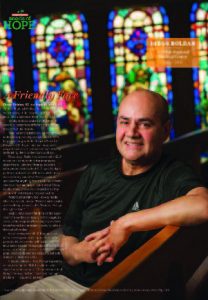 HEAVEN SENT
HEAVEN SENT
Diego Roldan, volunteer in the Emergency Department and Hospital Elder Life Program (HELP) at Trinitas, was recently named one of the five honorees in New Jersey Monthly’s annual Seeds of Hope program. Roldan was among 65 nominees from around the state who were considered for their influence and impact on others by supporting their communities, helping neighbors, and giving back. He frequently reads passages of the Bible to patients because he believes “God sent me here.”
John Emerson Photography, New Jersey Monthly magazine
 PROGRESS IN THE WORKS
PROGRESS IN THE WORKS
Trinitas Regional Medical Center celebrated the transformation of its Emergency Department with a ceremonial groundbreaking at the Williamson Street Campus. The $18 project to be completed in 2017 will expand the current patient exam areas to 45, up from 26, and renovate the center to move services like x-rays and CT scans closer to patients in order to accelerate delivery of emergency care. Donors, local community leaders, legislators, senior management, and members of the Emergency Department staff hailed the progress as a major step toward ensuring quality healthcare delivery to the City of Elizabeth and communities beyond.
 POWERHOUSE SURGEON
POWERHOUSE SURGEON
Labib E. Riachi, MD, FACOG, Chair of Obstetrics and Gynecology at Trinitas, has received subspecialty certification in pelvic medicine and reconstructive surgery by the Division of Female Pelvic Medicine and Reconstructive Surgery of the American Board of Obstetrics and Gynecology and the American Board of Urology. Since completing his training in 2001 under leading surgeons in women’s obstetrical/gynecological and urological health in Europe and the US, Dr. Riachi has performed more than 3500 of these surgeries at Trinitas.
 FORMULA FOR SUCCESS
FORMULA FOR SUCCESS
Chatham Day School hosts 4th Annual S.T.E.A.M. (Science, Technology, Engineering, Arts, and Math) Expo on Saturday, January 9, 2016 from 2:00-4:00 p.m. This event is free to the public and is excellent for the entire family.
TWO NEWCOMERS
Westfield Smiles Dental Health & Wellness Center, which has served area patients for more than three decades, recently w
elcomed two dentists to town. Dr. Maral Regas and Dr. Stephanie Arismendi joined Dr. Adam E. Feret’s general dental practice at 440 East Broad Street. “The best part of being a dentist is the feeling you made a positive difference by educating and helping patients protect their teeth and improve their smiles,” says Dr. Arismendi, a Rutgers grad. “Being part of the practice of Dr. Feret will allow me to continue to do that.”
 WOMAN OF INFLUENCE
WOMAN OF INFLUENCE
Teacher, clinical educator, and mentor, Dr. Purabi Bharatiya of the Trinitas Department of Psychiatry, was awarded the Archbishop J. John Myers Outstanding Educator Award in Medical Education from Seton Hall University. Dr. Bharatiya, along with Dr. Anwar Y. Ghali, Chairman of Psychiatry, created and developed the Trinitas Psychiatric Residency Program. She is shown with, from left, Gary S. Horan, President and CEO, Dr. Anwar Y. Ghali, and James McCreath, Vice President, Behavioral Health and Psychiatry.
 THE DOCTORS ARE IN
THE DOCTORS ARE IN
Drs. Sergio Baerga and Vasyl Pidkaminetskiy, physicians newly-affiliated with Trinitas, invited the community to the offices of Trini-tas Physicians’ Practice located on St. Georges Avenue in Rahway. Welcoming patients to the practice are from left, Joanna Ayala, Office Manger, Dr. Baerga, Eryn Mckenzie, Medical Assis-tant, and Dr. Pidkaminetskiy. Dr. Baerga is board certified in gen-eral surgery and fluent in Spanish and English while Dr. Pidkaminetskiy is board certified in family practice and internal medicine, with fluency in Ukranian, Russian, Polish and English.
 AIN’T IT GRAND!
AIN’T IT GRAND!
More than 200 guests, including NJ Senator Tom Kean Jr., attended the Grand Reopening party for The Kenilworth on September 29th. The boutique hotel renovated its 109 rooms and hired Rothweiler Event Designs to create 6,000 square feet of unique party and event spaces, including a downstairs lounge and an upstairs banquet facility. Both rooms showcased the offerings of The Kenilworth’s Executive Chef, Andrew Proto. “It was thrilling to have been able to introduce our contemporary vision of the Kenilworth,” said co-owner Sonali Mody. The kenilworthinn.com web site features a visual tour of the property.
EDGE takes you inside the area’s most creative kitchens.
The Office Beer Bar & Grill • Grilled Bratwurst
728 Thompson Ave. • BRIDGEWATER 411 North Ave. West • WESTFIELD 32–34 Chestnut St. • RIDGEWOOD
We fire finish our beer-braised bratwurst on the grill and serve it with sautéed onions and peppers on a char-grilled garlic-infused baguette.
— Kevin Felice, 40North Executive Chef.
 Paragon Tap & Table • Mushroom Tart
Paragon Tap & Table • Mushroom Tart
77 Central Ave. • CLARK
(732) 931-1776 • paragonnj.com
In additional to all of our craft beer and craft dishes, burgers, pastas and seasonal, local menu items, we are also very proud to offer our vegan and vegetarian experiences, including mushroom tart with roasted salsify, zucchini and French beans.
— Eric B. LeVine, Chef/Partner
 A Toute Heure/100 Steps Supper Club & Raw Bar
A Toute Heure/100 Steps Supper Club & Raw Bar
232 Centennial Avenue / 215 Centennial Avenue • CRANFORD
(908) 276-6600 • localrootscranford.com
Our restaurants offer the best ingredients from ocean, farm, and garden on their seasonal menus. As we head into winter, the ocean offers up some of our best seasonal options—from briny local oysters and mussels, to gorgeous local catch. The colder water temperatures mean a great abundance and amazing local flavors!
— Andrea & Jim Carbine, Owners
 The Black Horse Tavern & Pub • Summer Smoked Pork Chop
The Black Horse Tavern & Pub • Summer Smoked Pork Chop
1 West Main Street • MENDHAM
(973) 543–7300 • blackhorsenj.com
A succulent house-smoked chop served with micro spring herbs and Jersey blueberry gastrique.
— Kevin Felice, 40North Executive Chef
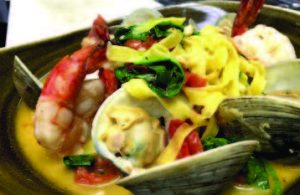 Piattino Neighborhood Bistro • Amalfi Seafood Pasta
Piattino Neighborhood Bistro • Amalfi Seafood Pasta
88 East Main Street • MENDHAM
(973) 543-0025 • piattinonj.com
Sautéed shrimp and clams, tomato, roasted garlic, spinach and white wine lobster broth over linguine.
— Kevin Felice, 40North Executive Chef
 The Office Beer Bar & Grill • Jersey “ Wake Up” Call
The Office Beer Bar & Grill • Jersey “ Wake Up” Call
619 Bloomfield Ave. • MONTCLAIR
(973) 783-2929 • office-beerbar.com/locations/montclair
Sirloin Burger topped with pork roll, American cheese and a fried egg. Lettuce, tomato and onion!
— Kevin Felice, 40North Executive Chef
 George and Martha’s American Grille • Sliced Hanger Steak
George and Martha’s American Grille • Sliced Hanger Steak
67 Morris Street • MORRISTOWN
(973) 267-4700 • georgeandmarthas.com
Served atop a sweet potato purée, with a wild mushroom demi-glaze and pan-roasted asparagus.
— Kevin Felice, 40North Executive Chef
 The Office Tavern Grill • Slow Roasted Chicken Tacos
The Office Tavern Grill • Slow Roasted Chicken Tacos
3 South Street • MORRISTOWN
(973) 285-0220 • officetaverngrill.com
Grilled flour tortilla, achiote spice, guacamole, queso fresco, cilantro and lime.
 Arirang Hibachi Steakhouse • Pan Seared Scallops
Arirang Hibachi Steakhouse • Pan Seared Scallops
1230 Route 22 West • MOUNTAINSIDE
(908) 518-9733 • partyonthegrill.com
Most guests think to visit us for an unforgettable hibachi meal, but we offer amazing traditional Japanese style dishes such as the pan seared scallops, served with a edamame purée, truffle scented greens, miso lime dressing and bok choy. We also offer the freshest sushi in the area.
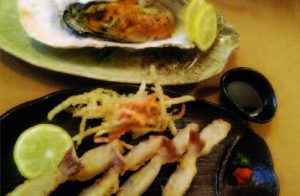 Daimatsu • Grilled Oyster
Daimatsu • Grilled Oyster
860 Mountain Ave. • MOUNTAINSIDE
(908) 233-7888 • daimatsusushibar.com
Fresh jumbo Pacific oyster grilled with homemade miso sauce, fried northern puffer fish marinated in light ginger soy coated in potato starch and deep fried crunchy veggie on the side.
— Momo, Chef
 Publick House • Shepherd’s Pie
Publick House • Shepherd’s Pie
899 Mountain Ave. • MOUNTAINSIDE
(908) 233-2355 • publickhousenj.com
Our Shepherd’s Pie is an authentic homage to our Irish roots. The slow braised lamb is so tender it practically melts in your mouth. The meat is mixed with fresh herbs and vegetables, creating a stew of rich, warm flavors. Topped with garlic potato puree and browned until crispy, it pairs beautifully with a pint of craft beer.
— Danilo Ayala, Executive Chef
 Luciano’s Ristorante & Lounge • House Made Mafalda Pasta Inverno Style
Luciano’s Ristorante & Lounge • House Made Mafalda Pasta Inverno Style
1579 Main Street • RAHWAY
(732) 815-1200 • lucianosristorante.com
Our goal is to give our guests a pleasurable dining experience, with fresh ingredients and personable service in a beautiful Tuscan décor complete with fireplaces. Our house-made Mafalda pasta features slow-braised artichoke crowns, cippolini onions and oven-dried tomatoes in a saffron cream broth. Luciano’s is available for dining and private parties of all types.
— Joseph Mastrella, Executive Chef/Partner
 Morris Tap & Grill • Grilled Brined Pork Chop
Morris Tap & Grill • Grilled Brined Pork Chop
500 Route 10 West • RANDOLPH
(973) 891-1776 • morristapandgrill.com
With the turn of the season we always change and add to our menu. We use local product to support area farmers and create seasonally to keep the menu at the peak of freshness. Grilled brined pork chop with roasted acorn squash and BBQ-dusted potato tots, maple garlic glaze.
— Eric B LeVine, Chef/Partner
 Spirit: Social Eatery and Bar • Jersey Breakfast Bar Pie
Spirit: Social Eatery and Bar • Jersey Breakfast Bar Pie
250 Morris Ave. • SPRINGFIELD
(973) 258-1600 • mclynns.com
Get in the Spirit! Our Jersey Breakfast Bar Pie features potatoes, Taylor ham, cheddar cheese and onions. It doesn’t get more Jersey than that!
— Mark Houlker, Chef
Thai Amarin • Goong Ma Kham
201 Morris Ave. • SPRINGFIELD
(973) 376-6300, (973) 376-6301 • thaiamarinnj.net
Batter fried jumbo shrimps with a tasty house made tamarind sauce, topped with roasted almonds and served on a bed of stir-fried spinach.
— Amy Thana, Owner
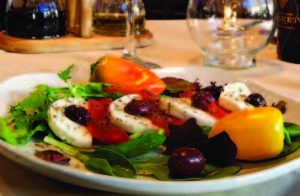 Café Z
Café Z
2333 Morris Avenue • UNION
(908) 686-4321 • CafeZNJ.com
Try our fresh mozzarella and roasted red pepper appetizer, perfect with a bottle of Coppola red wine. Every Friday night is live entertainment and dancing!
— Patricia Inghilleri, Owner
 Chestnut Chateau • Black Seabass
Chestnut Chateau • Black Seabass
649 Chestnut Street • UNION
(908) 964-8696 • chestnutchateaunj.com
As the cold weather is in full swing, everyone bundles up and likes to stay warm. I embrace the cold and use the best fish caught in the deep blue waters of our east coast. Black seabass is great whole or filleted. The flaky white meat is served with a browned butter sauce that’s garnished with capers, baby croutons, parsley and lemon supremes.
— George Niotis, Chef
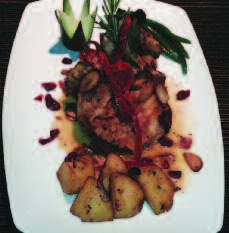 Mario’s Tutto Bene • Vinegar Pork Chops
Mario’s Tutto Bene • Vinegar Pork Chops
495 Chestnut Street • UNION
(908) 687-3250 • mariostuttobene.com
Our vinegar pork chops feature three thin-cut Frenched chops that are coated with Italian breadcrumbs and sautéed with sweet vinegar peppers, prosciutto and garlic. They arrive with house-made roasted or mashed potatoes. Our regulars love this entrée.
 Rio Rodizio • Brazilian Meats
Rio Rodizio • Brazilian Meats
2185 Rte. 22 West • UNION
(908) 206-0060 • riorodiziounion.com
We offer an “All-You-Can-Eat” dining experience transported straight from the streets of Rio de Janeiro to your tableside. Each customer gets to witness a never-ending parade of freshly roasted meat and poultry. Our authentic Gaucho chefs carve these melt-in-your-mouth meats to your liking.
 The Manor • Petite Filet Mignon & Short Ribs
The Manor • Petite Filet Mignon & Short Ribs
111 Prospect Avenue • WEST ORANGE
(973) 731-2360 • themanorrestaurant.com
Our hearty petite filet mignon, accompanied by oh-so-rich short ribs that have been braised to tender perfection are ideal for the season. Add to that grilled baby leeks, forage mushrooms scented in bordelaise sauce, caramelized cipollini onions, and a delightfully-presented potato purée in a crisp potato basket and you have a taste of autumn well worth the visit.
— Vincent Raith, Executive Chef
New Jersey’s local flavor is available all winter long.
To many travelers speeding at 80 mph on I-95, New Jersey seems largely industrial, but it still, as it’s license plates claim, is “The Garden State”. For a century or two, New Jersey was a stretch of rich farmland, the green grocer to surrounding metropolitan areas—New York to the north and Philadelphia to the southwest. At the 1876 Centennial Exhibition in Philadelphia, Abraham Browning, the former attorney general of New Jersey and owner of Cherry Hill Farm, referred to the state as an open-ended cornucopia filled with delicious foods with New Yorkers eating out of one end and Philadelphians eating out of the other. While Cherry Hill is now mostly developed, the state still grows a cornucopia of fruits and vegetables.
Over the years, the industrial and the garden elements of New Jersey have fused together in the food industry as some of the country’s largest food companies—Progresso, Campbell’s Soup, Seabrook Farms—manufacture in the state.
In summer months, everyone becomes a locavore with grocery stores and farmers’ markets offering a bounty of fresh, local produce. The fresh-picked tomatoes, peaches and corn all taste sweeter than any other time of the year. According to Bob Sickles, owner of Sickles Market in Little Silver, “local” has replaced “organic” as the foodie buzzword of the moment.

www.istockphoto.com
Just Peachy
In early summer, the harvest of ripe peaches in New Jersey brings homemade peach ice cream, peach pies and cobblers to many Garden State tables. If you didn’t get around to jarring your sweet peaches or making peach preserves, Circle M Farms bottles the sweet fruit flavor in the liquid form of a delicious peach cider that my son loves year round.
ToMAYto, ToMAHto
With the growing season is over and if you haven’t canned your own tomatoes, how can you recreate the tastes of summer in New Jersey? To make your own sauce any time of the year, Memet Wildirim, general manager of Ashley Market-place in West Orange, says Jersey Fresh Canned Tomatoes is a good product and sells well.
Standing among baskets of a variety of field grown tomatoes, ranging from Roma to Heirloom at Sickles Market, I asked Bob Sickles, what does New Jersey offer best, food-wise, year-round? “Tomato sauces rule!” he proclaims.
Some enterprising epicureans have bottled the fresh flavors of Garden State tomatoes. For instance, Market Basket, in Franklin Lakes, jars their own tomato sauce in large batches and sells it year-round. According to the store general manager, Dave Hamersmith, they also sell other premium quality New Jersey tomato sauces, such as Jersey Gravy.
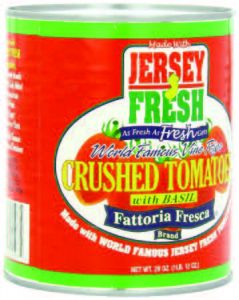 Bob Sickles explains that the local products excel over the mass-produced sauces. “While a larger production will process all the tomatoes, whether they are ripe or still green, and get a good sauce which has a higher acid flavor, the producers of the local sauces use hand-picked tomatoes and make sure they all are ripe. This creates a sweeter sauce, which is more work intensive and therefore has to be a bit more expensive. But it’s worth it.”
Bob Sickles explains that the local products excel over the mass-produced sauces. “While a larger production will process all the tomatoes, whether they are ripe or still green, and get a good sauce which has a higher acid flavor, the producers of the local sauces use hand-picked tomatoes and make sure they all are ripe. This creates a sweeter sauce, which is more work intensive and therefore has to be a bit more expensive. But it’s worth it.”
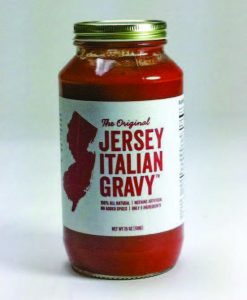 Not going on Bob’s word alone, we conducted a non-scientific tomato sauce taste test engaging four individuals with limited “foodie” credentials. In the mix were four New Jersey tomato sauces with slightly differing prices that can be purchased around the state—Nanina’s (25 cents per ounce) from Belleville, Manno’s (30 cents per ounce) from Bradley Beach, Jersey Italian Gravy (40 cents per ounce) from Ridgewood and Jar Goods (50 cents per ounce) from Hoboken—as well a bottle of Cabernet Sauvignon and a loaf of fresh ciabatta bread for dipping into the sauces.
Not going on Bob’s word alone, we conducted a non-scientific tomato sauce taste test engaging four individuals with limited “foodie” credentials. In the mix were four New Jersey tomato sauces with slightly differing prices that can be purchased around the state—Nanina’s (25 cents per ounce) from Belleville, Manno’s (30 cents per ounce) from Bradley Beach, Jersey Italian Gravy (40 cents per ounce) from Ridgewood and Jar Goods (50 cents per ounce) from Hoboken—as well a bottle of Cabernet Sauvignon and a loaf of fresh ciabatta bread for dipping into the sauces.
 According to our tasting panel, all the sauces were winners, yet different. The least expensive, Nanina’s, provides a very good, all-purpose kitchen staple. One taster’s favorite, Manno’s marinara, was particularly gutsy with herb and garlic flavors punching out on our palates. This sauce would be good with seafood. Delicious Jersey Gravy was thicker and sweet. And the rich, full-bodied Jar Goods was the densest sauce, almost like a paste, offering a fruity, sweet flavor.
According to our tasting panel, all the sauces were winners, yet different. The least expensive, Nanina’s, provides a very good, all-purpose kitchen staple. One taster’s favorite, Manno’s marinara, was particularly gutsy with herb and garlic flavors punching out on our palates. This sauce would be good with seafood. Delicious Jersey Gravy was thicker and sweet. And the rich, full-bodied Jar Goods was the densest sauce, almost like a paste, offering a fruity, sweet flavor.
Ramen Romance
When one thinks of fresh ramen noodles, the words “New Jersey” don’t come immediately to mind. Many of us would rather go ramen-less than to try to digest the curly dried noodles that look like a bad hair perm, reconstituted by water added to its chemical-based broth. Sun Noodles offers a totally different ramen experience. A few years ago Sun Noodle Brand, a producer of ramen for 30 years in Hawaii, opened a factory in Teterboro. Sun Noodles purveys its products to many Ramen shops in New York and now offers fresh ramen kits—with or without delicious, if sodium-saturated, broths—in a number of local Whole Foods and Asian markets. Yes, the dried version in your grocery store costs less than a dollar, but for fewer than five dollars, I bought the real deal at Whole Foods, garnished it with shrimp, bok choy and scallions and fed three healthy eaters. It may not be as divine as the steaming pork bone broth at Ippudo ramen shop in NYC, but it’s still delicious.
New Jersey is a food-lover’s paradise offering so many wonderful local products. For instance, there are a variety of barbeque sauces—Hoboken Eddies, Grandpa Baldy’s from Freehold, and Outer Limits hot sauces from Bayonne. Mazi Piri Piri sauce from Bradley Beach, First Field New Jersey Tomato Ketchup and Fourth Creek relishes from Rumson stand out. Enjoy the seasonal nectar of local bees’ labors with honeys, which are helpful to allergies as well as being anti-bacterial. There are many more gourmet cheeses, locally made sausages and hot dogs, and snack food. As the old advertisement goes, “Try it, you’ll like it!”
Editor’s Note: Sarah Rossbach has written for the New York Times, the Washington Post, House & Garden, and Harper’s Bazaar. When she’s not moonlighting as a feature writer for EDGE, Sarah stays busy as a feng shui consultant to designers and corporate and private clients in New York City. Vogue said of Sarah that “she is probably the American most responsible for introducing feng shui to the West.”





Reaction Time
Allergies are the result of a reaction that starts in the immune system. An allergy to eggs, for instance, means your immune system identifies a protein found in eggs as an allergen. Your immune system reacts by producing antibodies called Immunoglobulin E (IgE). These antibodies attach to cells in your skin, lungs and gastrointestinal (GI) tract. If you come in contact with the allergen again, the cells release chemicals including histamine, which cause food allergy symptoms such as itching, hives, swelling, diarrhea, wheezing and a potentially life-threatening reaction called anaphylaxis. Without immediate treatment—an injection of epinephrine and expert care in a hospital—anaphylaxis can be fatal.

www.istockphoto.com
How do I identify anaphylaxis as opposed to an allergic reaction?
An allergic reaction is responsible for affecting one organ, as is the case with common dermatological manifestations like urticaria (hives) and pruritis (itching). The signs of an allergic reaction can begin with something as simple as a rash to something more severe, such as shortness of breath and difficulty breathing. Anaphylaxis involves the skin and additional organs. On the spectrum of allergic responses, anaphylaxis is a profound reaction.
When does an allergic reaction demand a visit to the ER?
When you suspect anaphylaxis. Symptoms may include difficulty breathing, dizziness or loss of consciousness. If you experience any of these symptoms in the context of eating, immediately call 911. If you have known food allergies and have been prescribed auto-injectable epinephrine, use it and then call 911. In either case, don’t wait to see if your symptoms go away or get better on their own.
What are the typical causes of profound allergic reactions?
In 2014, an article in the Journal of Allergy Clinical Immunology found that anaphylaxis in adult patients was triggered 34% of the time by medications, 31% by food, 20% by insect stings and environmental allergens, 2.6% by latex, 1.2% by exercise, and 11% by unknown factors. When you factor in children, food allergy has become the most common cause of anaphylaxis overall in the United States.
Safety Steps
A good day for me and my staff is a day when we don’t have to treat an anaphylaxis case. There are some basic steps you can take to help make that happen…
- Always ask about ingredients when eating at restaurants or when eating foods prepared by family or friends.
- Carefully read food labels. The United States and many other countries require that major food allergens (milk, egg, fish, shellfish, tree nuts, wheat, peanuts and soybeans) be listed in easy-to-understand language.
- If applicable, carry with you—and know how to use auto-injectable epinephrine and antihistamines to treat emergency reactions.
- Teach family members and other people close to you how to use auto-injectable epinephrine and consider wearing an ID bracelet that describes your allergy.
- If a reaction occurs, have someone take you to the emergency room, even if symptoms subside. Afterwards, get follow-up care from your allergist.
What percentage of children have food allergies?
Generally, food allergy in children has an estimated prevalence of 8% in the United States, with approximately 150 deaths per year. Common food allergens include eggs, milk, soy, peanuts, tree nuts and shellfish. Tree nuts and peanuts are responsible for a large proportion of anaphylactic reactions. All patients with food allergies should avoid contact with these products, including contact with areas where these foods are prepared.
Can kids “outgrow” an allergic reaction to a food, ingredient or spice?
Most children outgrow their allergies to cow’s milk, egg, soy and wheat, even if they have a history of a severe reaction. However, shellfish allergy tends to persist through adulthood. Repeat allergy testing with your allergist can help you learn if you or your child’s food allergies are resolving with time.
I’m lactose intolerant. Does that mean I’m allergic to milk?
There is a difference between food allergy and food intolerance. A food allergy involves the immune system while food intolerance—and lactose intolerance is a good example—does not. Food intolerance typically involves the GI tract, causing uncomfortable symptoms like abdominal pain, nausea, vomiting and diarrhea. But there is no risk of anaphylaxis.

www.istockphoto.com
Can stress trigger allergies?
When you’re all stressed out, your body releases hormones and other chemical— including histamine, that powerful chemical that leads to allergy symptoms. While stress doesn’t actually cause allergies, it can make an allergic reaction worse by increasing the amount of histamine in your bloodstream.
 Do you have a hot topic for Dr. D’Angelo and his Trinitas ER team?
Do you have a hot topic for Dr. D’Angelo and his Trinitas ER team?
Submit your questions to AskDrD@edgemagonline.com
Editor’s Note: John D’Angelo, DO, is the Chairman of Emergency Medicine at Trinitas Regional Medical Center. He has been instrumental in introducing key emergency medical protocols at Trinitas, including the life-saving Code STemi, which significantly reduces the amount of time it takes for cardiac patients to move from the emergency setting to the cardiac catheterization lab for treatment.
An award-winning patient has transformed the culture of the Linden Dialysis Center.
For nearly four decades, Angela Taggart has successfully managed her renal failure through regular dialysis sessions, adherence to her doctors’ orders, and the support of her family. Even so, nothing has impacted her success as profoundly as her faith and her outlook—an outlook so inspiring that she was recently honored with the Patient Engagement Award from a major national renal disease network.

Photos by Kathryn Salamone
Angela’s sessions at the 5-star CMS-rated Linden Dialysis Center begin with a ritual Hello to each of her fellow patients. Ruby Codjoe, RN, is the Unit Manager of the facility, which is a satellite operation of Trinitas Regional Medical Center. She has known Angela as a patient for the last 20 years. Ruby strategically seats new patients, who are sometimes depressed and upset at their own conditions, next to Angela so she can spread her own life lessons, share her insights, and offer encouragement that renal disease doesn’t have to take over a person’s life
“It is amazing to witness,” Ruby says. “What begins with a simple introduction to a new patient who may be sad and depressed results in a more hopeful patient, thanks to Angela fostering a positive outlook in them.”
When it was time to nominate a patient for the annual Patient Engagement Award presented by Quality Insights Renal Network 3 (QIRN3), Ruby immediately submitted Angela’s name. “George Elliot once said, ‘It’s never too late to be who you might have been.’ It’s a perfect way to describe how Angela lives her life.”
Angela Taggart is an inspiration to all dialysis patients, according to Joan Wickizer, Patient Services Director at QIRN3. “The thing that struck us about Angela’s story was how she serves as a cheerleader for other patients,” she says. “And how, for more than 30 years. she’s maintained such a full, engaged life.”
For the record, it’s 38 years. Angela started dialysis at just 20 years old. She has made a point of trying to live every day as if it could be her last. In the early days of her treatment—following a failed kidney transplant that led to life-threatening complications—she was befriended by an elderly fellow patient who passed along life-changing advice: learn.
“He told me to take charge of my situation,” Angela remembers, “and learn what the machines do. Get involved in your treatment. Ask questions. By staying engaged, you take back your independence. I’ve been ‘in school’ for 38 years, and I never stop learning.”
In that spirit, Angela set a goal of returning to school and, in 1996, almost 20 years after being diagnosed with renal failure, she graduated from Kean University with a degree in Business Management and a teaching certificate for Special Education. A stint with AmeriCorps followed, and she went on to teach preschool at Rahway’s Destiny After School Haven, as well as substitute teaching for the Elizabeth and Rahway school systems.
The Patient Engagement Award notwithstanding, Angela doesn’t see herself as an example. In fact, when she was told she would be receiving the honor, she thought it was a practical joke.
“I think that sometimes I’m a complainer,” Angela laughs. “I’m constantly asking questions, wanting to know how things work or why they’re being done, advocating on behalf of the other patients.”
Indeed, she advises and inspires others grappling with their illness and treatment. Playing that role means staying in constant, persistent communication with the staff at the Linden Dialysis Center. Angela pays attention to the small details that can make dialysis a more positive experience, from better Wi-Fi service to the comfort of the chairs. She helps the center staff understand what it means to be a dialysis patient, including “bad days” when a patient might prefer simply to be left alone with the machine and a television.
 Angela reminds her fellow patients to never stop asking questions or learning about their own treatments. She encourages them to pay attention to their bodies and listen for cues, reminding them that nurses and doctors can only do so much; it’s up to the patients to communicate how they’re feeling and responding.
Angela reminds her fellow patients to never stop asking questions or learning about their own treatments. She encourages them to pay attention to their bodies and listen for cues, reminding them that nurses and doctors can only do so much; it’s up to the patients to communicate how they’re feeling and responding.
Angela says her strength is based in faith, and in her belief that prayer can work miracles. She is a leader in her Church community, and never stops looking for ways to transfer that faith and grace to her fellow patients. By initiating activities like a Birthday Card Campaign for patients who have left the center and the ‘Encourage Your Nurse’ project, she has turned the dialysis center into a real community, with a network of love and support.
Angela’s always seeking new ways to encourage other patients and the staff, and remains in Ruby’s words “tenacious, resilient, and ambitious.” Naturally, whenever the center gets a new machine or other equipment, she asks for the manual and reads it during treatment.
Angela is engaged…the recognition from QIRN3 confirms it.
She exemplifies the life of someone who truly cares for others and will do everything in her power…for everyone she comes in contact with reads the nomination submitted by Ruby Codjoe and other members of the Linden team. She is the example of beating the odds no matter the obstacles that come her way
A pair of recent breakthroughs hold promise for type 1 and type 2 sufferers
Americans may be living longer, but they’re also living sicker. Chronic and acute illnesses are on the rise, most notably diabetes. According to the American Diabetes Association (ADA), diabetes causes more deaths per year than breast cancer and AIDS combined. Diabetes affects 25.8 million Americans, about 8.3% of the population; it is the seventh leading cause of death in the U.S. and sixth in our state.

www.istockphoto.com
Not surprisingly, doctors have become hyper-vigilant when it comes to certain factors related to diabetic or pre-diabetic conditions. Nor should it come as a surprise that medical researchers and scientists around the world are working hard to find ways to prevent, manage and even cure this disease. In the last half of 2015 alone, several significant breakthroughs were reported. They ranged from new medical procedures to behavioral and dietary tweaks. Although a long-term magic-bullet cure is unlikely, the past year has produced some eye-opening results.
BioHub Breakthrough
A Texas woman named Wendy Peacock was introduced this summer as the first transplant recipient of a BioHub that mimics the pancreas. Peacock, who is in her 40s, was diagnosed with type 1 diabetes as a teenager and suffers from severe hypoglycemia unawareness—a dangerous drop in blood sugar that could cause her to faint without warning, or even slip into a coma while she’s asleep. With the implanted bio-engineered “mini-organ” she now has normal glucose levels and no longer needs to inject herself with supplemental insulin.
You Can Manage Your Diabetes!
 If you’ve just been diagnosed, or if you’ve been living with diabetes, quality medical care, encouragement and education can make a difference in your daily life.
If you’ve just been diagnosed, or if you’ve been living with diabetes, quality medical care, encouragement and education can make a difference in your daily life.
As an American Diabetes Association fully-accredited diabetes center, the Diabetes Management Center at Trinitas Regional Medical Center is a center you can trust to help you effectively manage your diabetes.

Ari Eckman, MD
Director, Trinitas Diabetes Management Center
Graduate of Johns-Hopkins University School of Medicine in Baltimore Specialist in Diabetes, Endocrinology & Metabolism committed to patient care and education
A respected staff of certified diabetes nurses, educators and nutritionists offer classes and one-on-one counseling
Quality medical care and attentive nursing support designed with you in mind to make diabetes a manageable part of your life
TRINITAS DIABETES MANAGEMENT CENTER
Medical Office Building, Suite 202 | 240 Williamson Street | Elizabeth, NJ | 908.994.5490THE HIGH COST OF HELPING
Statistics released by the ADA in 2013 on the cost of managing America’s diabetes problem were staggering:
- $245 billion: Total costs of diagnosed diabetes
- $176 billion for direct medical costs
- $69 billion in reduced productivity
A further breakdown of statistical evidence regarding diabetic-related expenses reveals:
- Inpatient hospital care (43%)
- Prescription medications to treat complications (18%)
- Anti-diabetic agents and diabetic supplies (12%)
- Physician office visits (9%)
- Nursing/residential facility stays (8%)
“As any type 1 knows, you live on a very structured schedule,” she said during a September press conference at the University of Miami Miller School of Medicine. “I do a mental checklist every day in my head: glucose tabs, food, glucometer, et cetera… Then I stop and say, ‘Wow! I don’t have to plan that anymore.’ Laying down at night and going to sleep and not having to worry about lows is something that is so foreign to me. It’s surreal to me. I’m still processing the fact that I’m not taking insulin anymore.”
The BioHub, which contains islet cells that restore natural insulin production, promises to be “a game-changer for millions of people,” according to Dr. Camillo Ricordi, who directed the project. Islet transplantation is not a new approach, but it has only been used in the liver until now.
The minimally invasive procedure required only three incisions, and doctors said they expected to perform 20 or 30 more at Miller School of Medicine in the coming year. And other diabetes centers will almost certainly join the BioHub trial.
Meanwhile, Peacock has no restrictions other than the diet and lifestyle a physician would recommend to any non-diabetic patient. “I feel like a great weight has been lifted,” she said, “I can breathe again.”
Type 1 diabetes is often referred to as Juvenile Diabetes, as it typically affects children and young adults. About one in every 600 children in the United States develops Type 1 diabetes, making it one of the most common chronic diseases in children. Symptoms usually occur during puberty, but it’s on the rise among younger children, some under the age of 5. Type 2 is often diet-related. It used to occur mainly in adults who were overweight and older than 40, however as childhood obesity rates rise, type 2 is on the rise among young people aged 10 and over. Per a 2012 CDC report, more than one-third of children and adolescents were overweight or obese. Childhood obesity has more than doubled in children and quadrupled in adolescents. Type 2 is not as life-threatening or dramatic as Type 1 at the time of diagnosis, but it can trigger serious long-term complications such as blindness, kidney disease, heart disease and limb amputation if left untreated.

www.istockphoto.com
THAT WOULD BE FALSE
According to the International Diabetes Federation, misconceptions about diabetes persist despite volumes of scientific and statistical evidence to the contrary:
- Diabetes only affects old people!
FALSE! Diabetes affects all age groups.
- Diabetes is not a killer disease!
FALSE! Diabetes is a global killer that is responsible for more than 4 million deaths a year. In fact, someone dies from diabetes-related complications about every 7 seconds.
- Diabetes predominantly affects men!
FALSE! Diabetes affects both men and women. In fact, diabetes today is on the rise among women along with a dramatic increase in Juvenile Diabetes.
- Diabetes cannot be prevented!
FALSE!Up to 80% of Type 2 diabetes is preventable by making healthy diet changes, increasing physical activity, and improving general lifestyle choices.
- Diabetes only affects prosperous societies!FALSE! Diabetes is a rising threat to all socio-economic groups, both in the US and globally.
Structure Settlement
Researchers looking at type 2 diabetes have begun to explore the way everyday foods are made. A study in England looked at what happens when the natural structure of dietary fiber is preserved during food production. The study’s findings, published in Diabetes Week, suggest that doing so slows the rise in blood sugar level following a meal. If this is indeed the case, it could lead to food products that look, feel and taste the same as existing products—but with an enzyme-resistant structure surrounding the starch, which would enable these foods to be digested more slowly.
The way starch is metabolized is relevant to a number of weight-related conditions, including type 2 diabetes.
The dietary fiber of grains forms a “protective” network of cell walls around starch. However, milling grains to produce different types of flour damages these cell walls, which enables the body to digest starch more quickly.
Study subjects were given a wheat porridge made of the identical ingredients, with one made of coarser particles and one finely milled. The people consuming the porridge with the larger particles showed 33 percent lower blood sugar levels after the meal, and insulin responses that were 43 percent lower. They also experienced less of a sugar crash.
The results strongly suggest that milling techniques that maintain the microstructure of grains such as wheat might be the key to a new wave of diabetic-friendly white bread, breakfast cereals and pasta.
Diabetes-related costs in the U.S. rose from $174 billion in 2007 to $245 billion in 2012—a 41 percent jump over 5 years. Medical expenses for diabetics, on average, are 2.3 times higher than for non-diabetics. Indirect costs such as absenteeism, reduced productivity, and disability claims cost untold additional billions. Within the scientific and medical communities, the disease is generally acknowledged as having reached pandemic proportions.
The hope is that a multinational, multifaceted approach to the problem will help turn those numbers around in the near future. Lifestyle modifications encouraging healthy eating habits and promoting physical activity can help lower risk of becoming of becoming obese and contracting related diseases. Ironically, the greatest challenge may not be the scientific hurdles, but instead the cultural ones. Humans are consuming more and exercising less. There may never be a cure for that.
Editor’s Note: Special thanks to Yelena Samofalov, MD of the Trinitas Pediatric Health Center for her input on this story. See page 66 for more from Dr. Samofalov on TRMC’s Eat Right Today! Program.
Read this story before you buy that painting!
Art is a very personal thing. You must like it when you buy it, because you may have to live with it. The chances of an average Joe (or Jane) finding something exceptional out of pure, dumb luck are probably less than 5 percent, meaning you’d have to gamble on 25 or 30 paintings before finding a monster bargain. Who’s got that kind of time? Or money? Or wall space?

www.istockphoto.com
If you are someone who has decided to invest a few thousand dollars (or much more) in high-quality art, and are determined to go it alone, the places you are most likely to encounter the painting that sings to you are an antique store, auction, estate sale or a gallery that specializes in older works or works of listed artists. Often, like true love, you find that special work of art when you aren’t even looking for it. An unseasoned buyer may panic and pass…or panic and overpay.
Things can get especially complicated if there is no signature and no attribution. How in the world do you get a value? How do you know the price a gallery or dealer or antique store slaps on a mystery painting is fair? Unfortunately, the answer is, “It’s a muscle you work over time.” Experience, research, some wins, some losses. Usually, the first thing I’ll ask myself in these situations is, “Does this painting accomplish what it’s supposed to accomplish?” That being said, my husband and I have both bought paintings that passed the basic sniff test, but ultimately weren’t what we wanted them to be.
If I form an emotional attachment to a painting, often that’s enough to spend $500 or $700. I have works of art that I adore with no signature and I couldn’t care less. They serve me well. And sometimes that’s okay. Again, buy what you like. That’s a decent starting point.
 So what’s my magic formula for buying smart? As I look back on my career and experiences as an art historian, dealer, appraiser and collector, I think it’s a little bit of patience, a fair amount of scholarship, and being in the right place at the right time. I offer as evidence four war stories…
So what’s my magic formula for buying smart? As I look back on my career and experiences as an art historian, dealer, appraiser and collector, I think it’s a little bit of patience, a fair amount of scholarship, and being in the right place at the right time. I offer as evidence four war stories…
YOUTH IS SERVED
When I was starting the field in the early 1980s, the gallery owner I worked for purchased an unsigned American impressionist painting for around $1,000. I felt it had been executed by John Leslie Breck (1859–1899), the artist who is often considered the first American to bring the French Impressionist art movement to the U.S., after befriending Monet. Breck died at 39, so his body of work was very small. I implored him not to sell it; I told him I had this hunch. This took me on another adventure. I knew someone in Boston at the St. Botolph Club, an exclusive arts club which, at the time, was still restricted to male membership. He arranged a private viewing of several Breck paintings and drawings they had in their amazing collection. I left completely convinced that the $1,000 painting was by him, which made it a $30,000 painting. Today, it might sell for over $300,000. I was just 22 years old at the time.

 ART BUYER’S CHECKLIST
ART BUYER’S CHECKLIST
The more you know, the less money you’re likely to blow so, as mentioned earlier, a little bit of scholarship can go a long way. However, anyone who comes across an old painting that “speaks to them” should be armed with a checklist to help keep a potential investment in perspective:
- Does it appeal to me?
- Is it likely to hold the same appeal to others?
- Does the subject matter make sense?
The old saying that a little knowledge can be a dangerous thing applies here. You may know that an artist’s work is prized, and make an educated guess on value. But have you considered what the subject of your painting is? If an artist is known for seascapes and you find a painting of his or her grandmother, you are not comparing apples to apples. You are comparing apples to oranges (or worse).
- Is the condition acceptable?
Here you have a little wiggle room. If a painting is centuries old and has damage or evidence of in-painting, you can live with that. If a painting is 50 years old and in poor condition, as an investment you really can’t tolerate that. Remember to check front and back.
- Has it been repaired?
Never ever compare a painting that’s been restored to one that is in pristine condition. The most obvious signs of repair is if a painting has been re-lined or if there is an application of another material. So for instance, reinforcement behind an oil on canvas means the integrity of the painting has been disrupted. There was a tear, or mold or water damage. Also, don’t spend serious money on a painting older than 1960 or so without first seeing it under a black light (a handheld one is a modest investment). New paint fluoresces. However, be aware that masking varnishes can be used—if it’s worth faking, it will be done.
- What info is on the back of the painting?
Are there numbers in the corner, drawn or written in chalk?This suggests that has been up for auction at some point and you may be able to find out more about it—including the selling price. Is there a label that says it was exhibited at a gallery or museum? Or is there some record of ownership? All of these details can be very helpful in your sleuthing; your goal is to extract the painting’s provenance, which can dramatically affect its value.
- Is it in a quality frame?
A period frame signed by the artist (usually just initials) indicates that he or she went to great expense to showcase the work.
- What does the seller know about the painting?
Never buy a painting without asking the seller what he or she knows about it. It is not out of bounds to ask where the seller bought it, either. Provenance can be critical in determining the fact behind a work of art, not to mention its value.
- Have you done any research?
A lot of people are discouraged researching art because auction sites generally don’t reveal selling prices unless you subscribe to a service, like Artfact or Artnext, that gives you access to this information. And auction sites are often among the first entries to come up in Google searches. The good news is there are some great free research sites, including ones run by the Getty Research Institute, the Smithsonian (Siris), the National Portrait Gallery, the Guggenheim, the Louvre and the National Gallery of Art.
- Is my information current?
Don’t assume that something that was worth “X” 20 years ago will be worth “2X” today. In the late 1990s, people were killing each other to buy Louis Icart. Now I can’t give them away.

www.istockphoto.com
FAIRY TALE ENDING
Once upon a time, we bought five small illustrations of nursery rhymes at a local auction. They were from the late 19th century and were exquisitely done. They bore no signatures. For the better part of 10 years, I tried to get attributions. I didn’t even know if they were American or British. I did feel strongly that they were done by a female artist. There were fingerprints—not literally, of course, but tantalizing clues. I did extensive research and contacted many colleagues in the art world, but could never get an exact match to an artist. We have a particular client who really likes unpublished illustrations. I pulled them out for him because I thought he might recognize the work. He loved seeing them, yet even he couldn’t shed any more light on their origin.
Some time later, we were up in Massachusetts visiting an art dealer friend. She happened to own a book from the same period that had never been published. She asked if I’d like to see it, and the instant I saw just the title page I knew exactly who my artist was. It was someone with whom I was well acquainted…I could have kicked myself! The artist was Laura Coombs Hills (1859–1952) and it turned out my illustrations were meant to be Christmas cards published by Louis Prang & Co. circa 1897. And with this new information, the value of the five pieces went up about eight times.

www.istockphoto.com
BUT I BOUGHT IT IN AN ANTIQUE STORE
Overpaying for art in antique stores happens from time to time. That doesn’t surprise me. There is not as much crossover in the fields of furniture and art as there should be, so some dealers don’t know a whole lot more about a painting than what they paid, and maybe what someone paid for something similar at an auction. That can lead to overpricing. However, it also means you can stumble past a phenomenal bargain without even realizing it. You may also have more negotiating room than with a dealer of fine art. Antique stores often try to buy items with a 100% markup in mind. This is because they deal with decorators, who take a big bite out of the pieces they purchase on behalf of their clients. It’s built into the business, so why not haggle a little?
 STEALING ONE FOR A C-NOTE
STEALING ONE FOR A C-NOTE
We were at an auction among people we knew had a lot of knowledge about fine art. A William Brice (1921–2008) painting came up. He was a California modernist. The pure quality of the painting drew us in. But the front of a painting tells you only so much. If you don’t look at the back, you’re missing a crucial part of the story—maybe even the whole story. In this case, there was an exhibition label on the back. That told us this particular painting was well recognized in its time, which was the 1950s.
No one else noticed. No one else bid. We got it for $100. Now his work is taking off. A well-advised collector would expect to pay in the neighborhood of $20,000 in today’s market for a piece of this quality, subject, size, condition and period.
I have to say, there’s a special satisfaction when you’re with the art mob and you manage to eke one out like that.
People know us and were watching us all auction to see what we were and weren’t bidding on. In this case we kept things very low-key.
A BEAUTIFUL CIRCLE
My husband attended a garage sale and the owner turned out to be friendly with a New Yorker illustrator. She had ended up with a lot of belongings from the illustrator’s estate. The collection was being housed in her garage. At the time, she wasn’t really ready to sell off her trove of illustrations. Our interest never waned.
The artist was Barbara Shermund (1899-1978), and she had been on the original team of illustrators for the magazine. My husband put me in charge of the research and inventory process. What a complete pleasure it was. We even had a retrospective exhibition for her witty and wonderful pen-and-ink original images.
We periodically looped back to her. We learned that she had gifted some of the works to her kids. And then, about two years later, we found out her garage had been broken into and also had experienced some minor flooding issues. That was the decisive moment; we convinced her to sell what remained—about 800 illustrations in all.
The Houghton Library Collection of American Illustrators learned about our find and a benefactor purchased more than 100 pieces and donated them to that library at Harvard. Liza Donnelly, a current illustrator at The New Yorker who was writing a book called Funny Ladies of The New Yorker, found out, too. She interviewed me for her very successful book. The artist’s great niece contacted me and wants to write the definitive book on her. There is also interest now from a museum in San Francisco to mount an exhibit of her illustrations.
SMARTPHONES LIVE UP TO THEIR NAME
You’ve found the painting of your dreams. It looks right, the price seems fair, but you’re just not sure. Time to whip out your smart phone. If you are a seasoned buyer, then you are already logged into a subscription service (AskArt costs $100/month) to help you determine its value. If not, don’t underestimate the power of eBay. You’re looking for “completed sales” (they’re in green—don’t look at the red prices—this recently changed). Type in your search words, go to refine, then show more, then sold items. What I like about this is that it shows you the good, the bad and the ugly. Look for the most recent auctions, and take note of any regional differences.
 QUICK! WHICH WOULD YOU PICK?
QUICK! WHICH WOULD YOU PICK?
Musicians or Venice? One is wall candy, the other runs into serious dollars. Made your decision? Okay, here goes…
 The Musicians painting on the left is what I would refer to as a decorative piece: pleasing to look at, easy to interpret and utilizing only a moderate degree of skill. It’s not a deep image, but it’s light, dynamic and charming, albeit somewhat superficial. The signature is completely indiscernible (this could be intentional) so I cannot look up the artist’s bio or see any type of track record. A closer look indicates materials that would not be considered high-quality or archival (stretcher wood, frame, canvas). In spite of this, it’s an enjoyable decoration, but that is its only value.
The Musicians painting on the left is what I would refer to as a decorative piece: pleasing to look at, easy to interpret and utilizing only a moderate degree of skill. It’s not a deep image, but it’s light, dynamic and charming, albeit somewhat superficial. The signature is completely indiscernible (this could be intentional) so I cannot look up the artist’s bio or see any type of track record. A closer look indicates materials that would not be considered high-quality or archival (stretcher wood, frame, canvas). In spite of this, it’s an enjoyable decoration, but that is its only value.
Venice, on the other hand, is a serious piece by Ida Dengrove (1915-2005)—a trained fine artist who is listed and easily researched. A bio reveals her schooling, exhibitions and many accomplishments. The painting itself employs a beautiful balance of perspective and color values, and is a homage to cubist painters who came before her.
There is a rhythm and an emotional tangibility to the scene. This view of busy Venetian streets is complex. Her deliberate brush strokes evoke a time, a place, a temperature, and so much more. Looking at the “verso” of this painting, you’d immediately see the finer quality materials as well as the labels and notes indicating a serious-minded artist.
 This was a great find, and a team effort that turned out to be very profitable. To me, as an art historian, however, the more important piece was that through luck and persistence, I was able to re-open and re-invent an artist whose life’s work was relegated to a suburban garage. Wow. This amazing journey has made me now want to shed more light on other artists from the first quarter of the 20th century. It also got me more interested in illustrations. It was a beautiful circle.
This was a great find, and a team effort that turned out to be very profitable. To me, as an art historian, however, the more important piece was that through luck and persistence, I was able to re-open and re-invent an artist whose life’s work was relegated to a suburban garage. Wow. This amazing journey has made me now want to shed more light on other artists from the first quarter of the 20th century. It also got me more interested in illustrations. It was a beautiful circle.
My first piece of advice to friends and clients who are embarking on this journey is don’t get discouraged before you even get out there. Very good art can slip through the cracks because of generational swings of taste and interest. It can pass down into the hands of a family member who doesn’t appreciate its quality.
And yes, sometimes it’s just sitting there, for no good reason at all, waiting for the average Joe (or Jane) to snap it up for a song.
Unless I beat you to it, of course.
Editor’s Note: The author’s husband, Chris, penned one of our most popular articles a couple of years back: Storage Warrior. Like all of our past stories, this one can be accessed at edgemagonline.com. Rose says he hasn’t shot himself recently with a gun-pen (now you’re curious, aren’t you?). The Myers own Shore Antique Center in Allenhurst.
A new book by columnist Rachel Weston digs into New Jersey’s agricultural bounty.
It’s a book about cooking, not a cookbook, Rachel Weston explains. The author of New Jersey Fresh: Four Seasons from Farm to Table is underselling her contribution to the popular American Palate series. Her book is not only the first of its kind within this regional collection, it stands alone as a thoughtful and engaging compendium of everything that bursts from the ground in the Garden State.
New Jersey Fresh begins by taking the reader inside the state’s farms and farmers markets, profiling people who have dedicated their lives to agriculture—some relatively new to the business, others who’ve been in it for generations. The bulk of the book is dedicated to produce by season.
Within each, every vegetable and fruit gets its due from Weston, who has crafted individual six-paragraph (or so) essays on fava beans, Swiss chard, nectarines, parsley and 50 other menu items. Those essays include tips and tricks for buying and preparing and, often, a look at how the state’s better restaurants serve them. At the back of the book is a collection of recipes from well-known Jersey chefs.
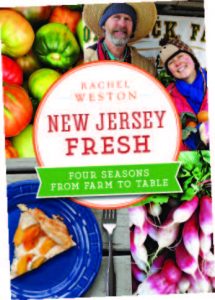
The History Press
“I was always interested in cooking,” says Weston.
She began her culinary journey as a girl, after her parents split, when she and her sister often cooked their meals while her mother worked. Her grandfather was a chef, so it was already folded into her DNA. An interest in journalism took her in a slightly different direction, however, as Weston worked for many years as a newspaper photo editor, including stints at the Asbury Park Press and Newark Star-Ledger.
BACK TO SCHOOL
In the early days of the recession, the Ledger offered buyouts to its longtime employees. Weston took the money and enrolled in Promise Culinary School in New Brunswick. The school is affiliated with Elijah’s Promise, an organization that aims to harness the power of food to “break the cycle of poverty, alleviate hunger and change lives.” From 2009 to 2014, she honed her skills at the Better World Café in Highland Park, the state’s first pay-what-you-can restaurant, which inspired Bon Jovi’s JBJ Soul Kitchen in Red Bank.
“I worked with an all-volunteer staff, many of whom came with no kitchen skills,” she recalls. “So I was always teaching. And at night, I taught at the culinary school.”

www.istockphoto.com
Weston was also thinking about putting her knowledge into prose. She reached out to her old newspaper contacts. The result was a weekly In Season column at nj.com, which in turn served as the inspiration for New Jersey Fresh.
The book was released in late spring 2015 and she’s been busy promoting it all summer and fall.
“I’ve really enjoyed meeting people during my appearances around the state,” Weston says. “One woman came up to me and said, ‘Rhubarb…what do you do with this?’”
From pages 51–52: I go a little rhubarb crazy and experiment like mad with new recipes every year. If you are lucky enough to have some rose bushes in bloom, rhubarb and rosewater syrup is wonderful as a base for cocktail or seltzer drinks. Drizzle some over your morning yogurt with chopped pistachios for a Persian flair. I like to bottle the pink syrup and give it as gifts.
As they say in food court…asked and answered.

www.istockphoto.com
BUYING LOCAL
In getting to know New Jersey’s farms and farmers, Weston also became acutely aware of the impact that individual shopping decisions can have. “When you are making a purchase at a supermarket versus a farmers market,” she points out, “it has a huge influence on the local culture and economy.”
Not that it’s possible to patronize farm stands for every shopping trip, Weston admits, but it’s worth the extra effort when you can, both for you and the farmer.
The nature of information-packed books is that authors, to their frustration, end up having to leave a few things out. What’s not in New Jersey Fresh?
“I would have liked to have gone beyond produce,” Weston says. “New Jersey makes wonderful cheeses. We have meat from pastured animals. And there are wonderful artisan food products made with locally grown produce. This book just touches on these things.”
According to her devoted readers, something else is “missing”: Weston’s own favorite recipes. This is the constant chorus from her readers, she says.
“So I’ve started work on a cookbook.”
SALAD & SQUASH
New Jersey Fresh: Four Seasons from Farm to Table features signature recipes from some of the state’s top restaurants. Here are two that would be a good fit for virtually any holiday table:
Endive Caesar Salad
The Orange Squirrel • Bloomfield
2 endive heads
1 pkg. marinated white anchovies (appx. 12) ½ cup fresh grated Parmesan
Dressing
1 egg yolk
½ tbsp. salt
½ tsp. dry mustard
2 tsp. lemon juice
1 tbsp. white wine vinegar
1 cup vegetable oil
½ tbsp. fresh ground pepper
1 tbsp. roasted pureed garlic
1 tbsp. Worcestershire sauce
- Whisk together the egg yolk and mustard. Slowly drizzle in oil while whisking to create an emulsion.
- After dressing is fully emulsified, add lemon juice, vinegar, garlic Worcestershire, salt and Parmesan.
- Cut apart endive. Dress each leaf individually and then stack about a dozen leaves, starting with the larger on the bottom and smaller on top, in a crisscross pattern.
- Top with 3 anchovies per salad.
- Sprinkle with grated cheese and black pepper. Option: add thin bread croutons as a garnish.
Acorn Squash Moranga Samba • Montclair
2 med. acorn squash
¼ cup extra virgin olive oil
2 med. White onions, diced
4 garlic cloves, minced
1 med. Butternut squash, diced 1 pt. heavy cream
1 13.5 ounce can of coconut milk 1 pound jumbo shrimp
¼ cup shaved Parmesan parsley & cilantro for garnish
- Cut acorn squash in half and remove seeds, creating a bowl. Cover with aluminum foil and cook at 350 degrees (60 to 75 minutes) until tender.
- Heat oil in a large skillet. Over medium heat bloom the onion with garlic and caramelize the butternut squash. When squash is tender, add the heavy cream and coconut milk and simmer.
- Add shrimp and cook for another 4 minutes.
- Pour the cooked butternut squash and shrimp mixture into the acorn squash. Garnish with parsley, cilantro and Parmesan.

Chef Francesco Palmieri/The Orange Squirrel
Editor’s Note: New Jersey Fresh (Arcadia/History Press, 2015, $19.99) is available at bookstores and other retail outlets around the state, and as an eBook. However, if you order directly from the author at racheljweston.com, you’ll receive your copy signed! Her web site also has a schedule of personal appearances and demos.
Discovering the Galapagos
Penguins darting like torpedoes between boats moored in clear blue water. Barking sea lions jostling for the best seat on the pier’s benches. Those were the sights and sounds that greeted the water taxi as it pulled into Puerto Villamil on Isabela Island, the largest in the Galapagos archipelago. It was a dramatically different world from mainland Ecuador. Or any other place I had seen as a globetrotting journalist. In a word, it was magical.
The plan was to island-hop with the goal of seeing as many of the famously unique species as humanly possible. According to the Galapagos Conservancy, about 80 percent of the land birds, 97 percent of the reptiles and land mammals, and more than 30 percent of the plants are endemic. The best months to visit are August through November because the migratory patterns of just about all the animals, birds, reptiles and fish bring them into view on the islands during this window.
Most Americans tour the Galapagos on some kind of group excursion. Getting to know strangers from other places—and experiencing the islands through their eyes—can be part of the fun.
 The members of my international crew were actually part of a sort of extended family. My Ukrainian-American mother, Christina, had retired to a seaside village in Ecuador a few years ago. Her Ecuadorian friend, Maria, came up with the idea to make the trip to the islands (which sit roughly 600 miles off the Ecuadorian coast). It turns out Maria’s parents had actually lived on one of the islands, Floriana, some 70 years ago, when her father worked for the government. Yet neither Maria nor my mother had ever been.
The members of my international crew were actually part of a sort of extended family. My Ukrainian-American mother, Christina, had retired to a seaside village in Ecuador a few years ago. Her Ecuadorian friend, Maria, came up with the idea to make the trip to the islands (which sit roughly 600 miles off the Ecuadorian coast). It turns out Maria’s parents had actually lived on one of the islands, Floriana, some 70 years ago, when her father worked for the government. Yet neither Maria nor my mother had ever been.
Maria’s husband, Washington, knew the Galapagos. He’d been stationed there while serving in the Ecuadorian military in the 1970s. Our trip would be his first time back. Maria and Washington’s adult children, Cristina and Santiago, were the fourth and fifth members of the entourage. Cristina attends university in Germany; Santiago works in Quito and had visited the Galapagos as a boy. I flew in from Washington D.C. and Cristina’s friend, Louis, traveled from the United Kingdom to make it a lucky seven.
 We began our journey in Puerto Ayora, most populous town on Santa Cruz and the tourist hub of the islands. There we began our love affair with Galapagos snorkeling. The biodiversity was astounding, though not always what I’d expected. I’ve done a lot of snorkeling in warm water, including the Red Sea, where colorful fish and plants live among stunning coral formations. In the frigid waters off Santa Cruz, the colors were muted and the sea floor crowded with starfish, sea cucumbers and various non-tropical fish species. In the deep water areas sharks swam stealthily below us.
We began our journey in Puerto Ayora, most populous town on Santa Cruz and the tourist hub of the islands. There we began our love affair with Galapagos snorkeling. The biodiversity was astounding, though not always what I’d expected. I’ve done a lot of snorkeling in warm water, including the Red Sea, where colorful fish and plants live among stunning coral formations. In the frigid waters off Santa Cruz, the colors were muted and the sea floor crowded with starfish, sea cucumbers and various non-tropical fish species. In the deep water areas sharks swam stealthily below us.
Las Grietas, off Santa Cruz, translates to The Crevices. It was unforgettable. After a water taxi ride to Finch Bay and a 20-or-so-minute hike past a swanky hotel and idyllic lagoons, we swam between tall cliffs with rock walls that plunged deep into water so crystal-clear water you could see right down to the bottom.
 THE LOCALS
THE LOCALS
While tourism may be the one and only industry on the islands, the attitude toward actual tourists can be uneven. For example, the owner of our hotel on Santa Cruz barely apologized for canceling one of our three reserved rooms, forcing me, my mother, Washington and Maria to be roommates for a night.
“The main income for Galapagos is tourism,” Santiago explained, “but they are not focused on the service aspect of tourism. [Many of the guides] try to trick you in order for you to hire them for everything, and they charge you whatever they want.”
Santiago, I had come to realize, possessed a highly developed sense of honor. During dinner one night a waitress mistakenly charged us for 6 entrees instead of 7. After reviewing the bill, he corrected the error as opposed to staying silent. Santiago felt everyone should at least attempt to live up to his basic standards of fairness, so when it came to the lackadaisical attitude towards tourists, as an Ecuadorian, he said he felt “annoyed and embarrassed.”
Washington added that “the taxi drivers were fine—they were quite helpful,” but, like father like son, he echoed Santiago’s sentiment about the folks in the tourist trade. “They’re kind of careless. They seem to think that, because people are going to come to the islands anyway, it doesn’t matter what they do or how you treat them. They should change that mentality.”
A few days later, on Isabela, we visited the shallower waters of the Tintoreras inlets situated just off the island. On the short Panga ride there, we saw penguins posted up on volcanic-rock islands and bright red crabs basking in the sun. Once in the water, we spotted decades-old sea turtles floating gracefully near the sea floor, and sea lions swimming close enough to grab.
“I wasn’t expecting to see the animals so close,” Louis marveled. Louis (who was half-French) turned out to be our Jacques Cousteau junior. His Go-Pro camera was always pointed at something. With Cristina’s help, he documented everything we saw above the water and below. As a bonus, Louis used his Spanish skills to extract inside information from our guides and taxi drivers.
While on Isabela we stayed in Puerto Villamil. It is a sleepy town compared to Puerta Ayora, on Santa Cruz. On the Sunday we arrived, all the shops were closed and it felt nearly uninhabited. We were lucky to find cold beer and a local woman under a walkway bridge to the beach frying up and selling the most delicious homemade meat or cheese empanadas. She made them using cassava dough, which is gluten free, instead of the flour dough I am used to in the United States.

 GALAPAGOS IN A BOX
GALAPAGOS IN A BOX
The Galapagos Islands are an archipelago of volcanic islands straddling the equator in the Pacific Ocean. They were declared a province of Ecuador in 1973. About 25,000 people live on 18 primary islands and 3 smaller ones. The Galapagos Islands are in the cold-water Humboldt Current, which affects the water temperature and weather.
We gorged on empanadas as we took in the spectacular Malecon Cuna del Sol, a long white-sand beach surrounded by palm trees and brackish water lagoons. As I strolled along the shore later I thought my eyes deceived me. The black lava rock barrier between the sand and surf appeared to mo
ve. As I got closer I saw hundreds (and probably thousands) of land iguanas blending right in and sunning themselves.
Day after day, we ticked off items on our Galapagos bucket list. We visited Rancho Primicias, a private farm and tortoise sanctuary where the giant reptiles have free range. We strolled barefoot along the beach at Garrapaterro, where flamingos nest in the surrounding lagoons. We hiked nearly
45 minute to Tortuga Bay’s beaches to kayak and watch birds and iguanas. An 8 mile round-trip walk brought us to the Wall of Tears, a 20-foot stone wall stretching more than 300 feet that was built by prisoners at a penal colony that once existed on Isabela Island.
We walked nearly everywhere. It reminded Washington of his days as a solider on the Galapagos. Weighted down by a backpack full of gear and a gun, he recalled using his machete to hack his way through raw vegetation to get from shore to shore on just about all of the islands. Today long trails leading to many of the beaches are laid with paver stones. Other paths are made of packed earth with wooden bridges across lagoon marshes. Though traversing the land is much easier than when Maria’s parents lived there, or when Washington was in uniform, one of the takeaways was that a Galapagos vacation is an active one.
 My mother, who is nearly 70, is in pretty good health and full of energy. She observed that many of the activities may be too challenging for families with small children or people with a physical infirmity, even a slight one, due to some of the terrain like steep steps, long walks and the need to constantly climb in and out of small boats.
My mother, who is nearly 70, is in pretty good health and full of energy. She observed that many of the activities may be too challenging for families with small children or people with a physical infirmity, even a slight one, due to some of the terrain like steep steps, long walks and the need to constantly climb in and out of small boats.
Unanticipated costs were an occasional source of angst. We’re talking about nominal fees, such as paying for a separate water taxi after buying a full fare ferry ticket, or a small entrance fee to another island on top of the $100 tax for foreigners already paid at the main airport. But they were annoying nonetheless.
One thing that really surprised me was the amount of trash we saw. As advertised, the Galapagos Islands are an ecological wonder to be treated with great care. On the plane in, flight attendants walked through the cabin, opened the over-head bins and sprayed our luggage with some sort of anti-microbial to protect the fragile eco system from critters we may have brought with us. The effort to conserve and maintain protected breeding spaces for species like tortoises, Darwin’s finches, Blue-Footed Boobies and a range of flora and fauna is obvious and organized. That made the lax attitude toward litter even more puzzling. It was not uncommon to see trash blowing around the streets of the more populated areas, or plastic bags and cans wedged under bushes at tourist arrival points.
Where food and souvenir prices are concerned, the regulatory hand of the Ecuadorian government is always evident. That tiny carved tortoise will run $3 dollars whether you find it at the main airport on Baltra Island or at a shop on Santa Cruz. Prices in the restaurants may vary, but not by much, and are exceedingly inexpensive. And, no matter where we went, the food— including fresh ceviche, lobster, giant prawns and cassava dumplings—was delicious.
Though we could get very close to the wildlife, we respected the admonition not to touch any animals. Human scent can cause an animal to be alienated from its group. That being said, while snorkeling Cristina was practically assaulted by a sea lion determined to play.
“I wasn’t touching him…he was touching me!” she laughed, as we peeled off our wetsuits.
In the end, whatever hiccups we experienced on this adventure were completely overshadowed by the unique beauty of the Galapagos Islands and its myriad creatures. It was far from a flawlessly choreographed Disney Land experience, but that was part of the charm.
“You come here for nature and not luxury,” Louis observed. “I think in that way I wasn’t just ‘not disappointed.’ It far exceeded my expectations.”
It was a sentiment we all shared. This may have been my first adventure to the land made famous by Charles Darwin, but it certainly won’t be my last. EDGE
Editor’s Note: Tetiana Anderson writes for a wide range of newspapers, magazines and web sites and has produced news stories for CBS, CNN and The Weather Channel. She won a New York Press Club Award for her reporting in 2012, and interviewed rap star 50 Cent the last time she contributed to EDGE.
New Jersey’s craft brewery count reaches 36.
There are only two edibles I don’t much like, and those are coffee and beer. Coffee because I’m somewhat allergic to it and beer because, well, I don’t like the taste of it.
There, I said it. That’s how I can relate to people who shun olives or cilantro or broccoli or any of the other foods I personally find essential to happiness. I get I don’t like because I don’t like beer.

Bolero Snort
Then I met Jaret Gelb, the brewer. I love Jaret, and I love Jaret’s passion for brewing; his understanding of the techniques, a merger of art and science; his devotion to his baby, Dark City, the Asbury Park brewery that may well be open by the time you read this. I’ve loved listening to Jaret talk about beer and learning about the network of brewers—most of them in their 20s and 30s—that is behind the 36 functional breweries in the state of New Jersey.
Thirty-six? I ask myself as I talk to Scott Wells, who, along with Bob Olson and Andrew Maiorana, are the principals behind Bolero Snort, the Ridgefield Park-based brewery that has followers who can be described as intelligently fanatical, because Bolero Snort makes top-of-the-world-class beer that beer geeks line up to buy upon release. When did 36 craft breweries happen to New Jersey, birthplace of Ballantine?
Collaboration happened to Wells, Olson and Maiorana at a chance meeting in a Staples that Wells was managing. Olson came in wearing a Bolero Snort shirt.
“I was a craft brew nut and I was planning to go to Bolero Snort’s release party,” Wells said. The next thing Wells knew, he was helping out at Bolero events. Before long, he was saying bye-bye to Staples and on board full-time at Bolero. Brews become blood quickly in this burgeoning world.
Kevin Sharpe, Dark City’s founder and, along with Jaret Gelb, a brewer, talks the family talk when he explains how his baby was born.

Dark City Brewing
“I am very lucky to have a small team of business partners and support staff who I now consider my family,” Sharpe says. Everybody wears many hats, he adds. Everybody likely will continue to be so adorned as the brewery grows.
Spellbound, in Mount Holly, is another brewery the merry bands of brother and sister brewers in New Jersey respect. Who are these guys? Mike Oliver, John Companick and Scott Reading. They like to say they have been “collectively brewing for 50 years.” The Spellbound team focuses on “everyday beers” as well as “extreme styles, like imperial stouts, barley wines and gruits.”
Go to the pilot batch tasting room in Mount Holly to try beers you won’t find anywhere else: Peach Double IPA, Vanilla Maple Porter, Jalepeno Ghost Pepper IPA, White Sage Black Pepper Saison.
Scott Wells and Jaret Gelb touted Spellbound to me, as well as a Fairfield-based brewery called Magnify, which is run by two Eric(h)s: Eric Ruta, founder and president, and Erich Carrle, head brewer.

Dark City Brewing
Please understand, all these guys talk brewing on many levels, not the least of which are: taste, taste, taste, and principles, principles, principles. Magnify, for instance, has four core, year-round beers—Vine Shine IPA, Search Saison, Pale Ale and Black Wheat Ale—but releases “small-batch experimental and innovative beers every four to six weeks.” They keep things interesting.
However, their business model is all about ethics. Magnify self-distributes, so the folks who brew can deal directly with the folks who drink the brews. Magnify is committed to environmental sustainability, employing energy-saving equipment, using recyclable materials, donating spent grain to farmers. Magnify is also about community partnerships and synergy.
Dark City’s Sharpe hammers home the community partnership theme, as well. In fact, Dark City is “actually the nickname for Asbury Park,” he says. “We chose the name to pay tribute to the city’s rich history of periods of downtime followed by rapid revival. The city is currently booming like never before and we love where it is going, but we don’t want to forget where it’s been.
“Asbury has been a hotbed of musical, artistic and culinary inventiveness for most of its history,” Sharpe adds. “Never in history has it housed a brewery, and I wanted to bring that to the community.”

Magnify Brewing
Every beer geek I spoke with talked community on every level. Local isn’t just a buzzword for these folks; it’s religion. Wells, whose technical title at Bolero Snort is sales and events manager, has at his finger tips all the information I need about Bolero’s seasonal program (“We pump out a different beer every month”), as well as the background a neophyte needs to fill gaps (“New Jersey is one of the toughest markets in the U.S.; it was the last market Best Buy went into” and “A contract brewery is one without its own physical plant—it brews by contract elsewhere”), but he also has perspective.
“In New Jersey, we all work to help each other,” Wells says. When Spellbound, for example, celebrates a release, the brother/sisterhood gathers to help. “New Jersey breweries are learning to compete against the national brands—Founders, Dogfish.”

Magnify Brewing
Sharpe agrees: “New Jersey’s brew scene, compared to other states, is relatively young. [However], we have the population to support this growing scene.” Dark City and the other “newcomers to the Jersey scene are lucky…that there are a large number of folks who’ve acquired a taste for craft beer. We owe that to the pioneers [such as] Climax, Flying Fish and River Horse [as well as] the relatively young innovators like Carton and Kane.”
These newcomers take local’s yesterdays, fuse them with local’s today and make dreams come true about local’s tomorrow. I think I’m acquiring a taste for the stuff.
Thanks, Jaret.

Spellbound
BREW CRAWL
Bolero Snort Brewery • bolerosnort.com
65 Railroad Ave. • Ridgefield Park
Dark City Brewing • darkcitybrewing.com 802 2nd Ave. • Asbury Park
Magnify Brewing Co. • magnifybrewing.com 1275 Railroad Ave. • Fairfield
Spellbound Brewing • spellboundbrewing.com 10 Lippincott Lane • Mount Holly
Editor’s Note: Andy Clurfeld has been shouldering the load on restaurant reviews since the second issue of EDGE. During that time, she was a 2010 Pulitzer Prize finalist in Public Service for her work exposing the flaws, injustices and abuses in New Jersey’s property tax system. Andy also has published in-depth reporting on a range of topics, including criminal street gangs, agriculture, politics and the environment. A longtime member of the James Beard Restaurant & Chef Awards Committee, she is a specialist in artisan wines and recently was appointed Wine Director at Buy-Rite Corporation, implementing educational programs, coordinating special events and developing artisan wine sections for select stores.
You will never see Joe Morton on one of those online lists of 10 Director’s Nightmares. He has the unique ability to blend seamlessly into an ensemble cast while simultaneously making every part his own. He commands attention and respect without chewing the scenery. He conveys nuanced emotion without uttering a word, yet when he speaks he can dramatically alter the pace and direction of a scene. Morton portrays good guys, bad guys, scientists and aliens with equal aplomb, which makes him one of Hollywood’s most in-demand actors. As CIA black ops boss Rowan Pope on ABC’s hit series Scandal, he gets to play one of the tastiest characters of his career. Robert Piper caught up with Morton in Los Angeles, three time zones away from his New Jersey home.
EDGE: Your character Rowan Pope on Scandal is the quintessential nightmare dad. You’ve played so many good guys over the years, is it kind of fun playing a bad guy?
JM: Absolutely! When I came out to LA, I was actually looking for a really smart bad guy and this guy literally fell into my lap. So, it was perfect timing on everybody’s part.
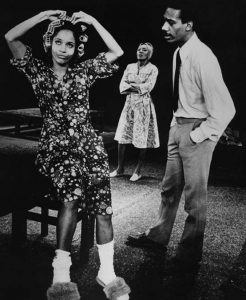
Sony Broadway
EDGE: You’ve actually played a number of complex dads over the years. What kind of dad did you grow up with?
JM: My father was an Army captain and his job was to integrate the armed forces overseas. That meant that he and his family sort of showed up at whatever army post he was sent to, racially unannounced. When we arrived, all [hell] sort of would break loose. It was rough wherever we were. So that was my model. That kind of discipline, that kind of strength, that kind of courage in a certain way. It’s kind of what Rowan Pope is endowed with.
EDGE: Did we see any of Joe Sr. in Lone Star?
JM: Oh, absolutely! My father died when I was 10, so I think that a lot of who I am as an adult is some sort of—“reflection” is not exactly the right word—but an “investigation” of who my father was.

Cinecom Pictures
EDGE: Lone Star was your third movie with John Sayles. Was there a New Jersey connection at that point?
JM: I moved to Jersey after The Brother from Another Planet. It was somewhere in the middle of all of that. But it wasn’t so much the Jersey connection. When we did The Brother, we sort of enjoyed working together. He’s very loyal to the actors that work with him. So he would invite many of us back.
EDGE: What do you feel distinguishes Sayles as a film maker?
JM: Well he’s a social “commentarian,” isn’t he? His movies aren’t simply about good guys and bad guys. They’re usually about workers in management, people sort of in their lives, having to work and deal with authority figures. So I think a lot of what his work is about is the common man dealing with the powers that be.
EDGE: What were the challenges working out your character, who was a mute alien, in The Brother from Another Planet?
JM: It was a lot of fun. Because he couldn’t speak, that sort of allowed me to use my whole body to express whatever it is that needed to be expressed, and just gave another dimension to the joy of that character in a way that I hadn’t found in other characters. Also, the idea of a black man who has tons of talents but no place to channel them at all because of his social and economical situation, who couldn’t move forward, is what I really loved about the script and about the character. I loved what John and I created in that movie.
EDGE: Earlier in your career, you had interesting roles in a sitcom, soap operas and on the stage. Who were the people who influenced your approach to acting during those times?
JM: Probably my teachers. I had some wonderful teachers at Hofstra University, including Carol Sica and Miriam Tulin. I probably didn’t start thinking about acting until I got to college. A lot of what they taught me—how to approach a character, what my investment in the story was, what I wanted essentially—was what I was using at that period of my life. And still today.
EDGE: What do you consider your first really good performance?

TriStar Pictures
JM: [Laughs] My first really good performance. Hmm. Well, it depends. On a professional level? The Brother from Another Planet is still my favorite film. I played Colin Powell on stage in Stuff Happens, which was an amazing experience.
EDGE: You’ve served as a narrator on a number of historical projects. Are you a fan of history?
JM: I am, yes.
EDGE: You’ve also worked on dozens of TV series. Is there a moment that stands out as being particularly memorable?
JM: I did a series years ago called Equal Justice. Vanessa Bell Calloway played my wife or played my girlfriend in the series and she got killed. I’m a lawyer, the head prosecutor. I don’t necessarily try that case, but I find out later that the guy gets off, he gets away with it. There was a moment between Cotter Smith and me in an empty courtroom were he tells me what happened, and I sort of respond to it. That’s one of those moments where you’ve hit it and you know you’ve hit it. It felt really good.
EDGE: Is directing something you’d like to do more of?
JM: I would. I was hoping that Proof was going to carry on a bit longer. I was hoping to direct an episode or two of that. So yes, I would like to do more directing. I really enjoy it.
EDGE: Where do you go for “local flavor” when you’re home?
JM: I enjoy cooking, so I don’t go out to restaurants often. But when I don’t feel like cooking—or have just returned from traveling and just want to go out quickly to get something to eat—I tend to go to the Court Jester in Matawan. It’s near where I’m staying. It’s a cozy sports bar. I like the easy vibe of it.
EDGE: What is it that drew you to New Jersey?

Photo by Bobby Quillard
JM: Well, I was married and I had kids, young children at the time. Montclair, if it has an industry, it’s education—it has great public schools. So we found this house on a cul-de-sac, next to a park, with a red-leaf oak in front of the house. And that’s what drew us to New Jersey. It was a place that we could afford and it had great schools. It was this beautiful sort of diverse neighborhood, that had a park at the end of it, and that’s what got us there.
EDGE: What have you come to appreciate most about the Garden State?
JM: I think the thing that comes to mind always is that most people outside of New Jersey only think of what they see when they exit either tunnel on their way out of the city. What’s great about the Garden State is just that—that it is a garden state. It’s actually a beautiful state. There are areas of New Jersey that are just wonderfully attractive and beautiful, especially in the fall. It’s not the oil refineries or whatever is outside of the tunnels. People need to spend more time looking at the landscapes of New Jersey.
Editor’s Note: Robert Piper is a freelance writer based in Chicago. He has written extensively on the subject of meditation and has taught physicians, psychologists, physical therapists, athletes, and business professionals. Robert spent nine and half years studying with a Taoist monk until he received the title of Master. He is the author of the popular book Meditation Muscle.

















